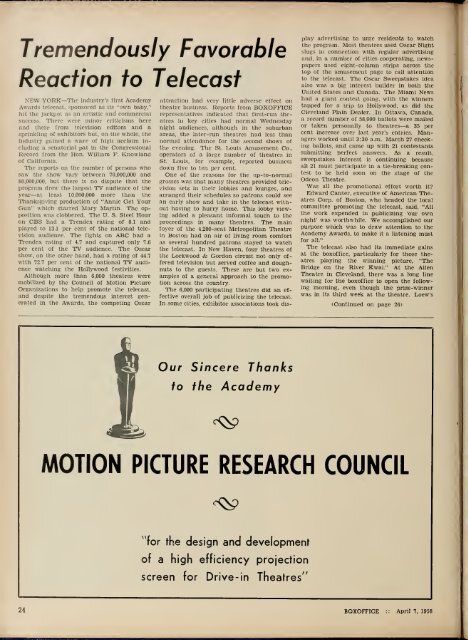Boxoffice-April.07.1958
You also want an ePaper? Increase the reach of your titles
YUMPU automatically turns print PDFs into web optimized ePapers that Google loves.
Tremendously Favorable<br />
Reaction to Telecast<br />
NEW YORK—The industry's first Academy<br />
Awards telecast, sponsored as itxS "own baby,"<br />
liit tJie jackpot as an artistic and commercial<br />
success. There were minor criticisms here<br />
and there from television editors and a<br />
sprinkling of exhibitors but. on the whole, the<br />
industry pained a wave of high acclaim including<br />
a senatorial pat in the Congres-sional<br />
Record from the Hon. William P. Knowland<br />
of California.<br />
The reports on the number of persons who<br />
saw the show varj- between 70,000,000 and<br />
80.000.000. but there is no dispute that the<br />
program drew the largest TV audience of the<br />
year—at least 10.000,000 more than the<br />
Thanksgiving production of "Annie Get Your<br />
Gun" which starred Mary Martin. The opposition<br />
was clobbered. The U. S. Steel Hour<br />
on CBS had a Trendex rating of 8.1 and<br />
played to 13.1 per cent of the national television<br />
audience. The fights on ABC had a<br />
Trendex rating of 4.7 and captured only 7.6<br />
per cent of the TV audience. The Oscar<br />
show, on the other hand, had a rating of 44.7<br />
with 72.7 per cent of the national TV audience<br />
watching the Hollj^vood festivities.<br />
Although more than 6,000 theatres were<br />
mobilized by the Council of Motion Picture<br />
Organizations to help promote the telecast,<br />
and despite the tremendous interest generated<br />
in the Awards, the competing Oscar<br />
attraction had very little adverse effect on<br />
theatre business. Reixjrts from BOXOmCE<br />
representatives indicated that first-run theatres<br />
In key cities had normal Wednesday<br />
night audiences, although in the suburban<br />
areas, the later-run theatres had less than<br />
normal attendance for the second shows ol<br />
the evening. The St. Louis Amusement Co.,<br />
operators of a large number of theatres in<br />
St. LouLs, for example, reported business<br />
down five to ten per cent.<br />
One of the reasons for the up-to-nonnal<br />
grosses was that many theatres provided television<br />
sets in their lobbies and lounges, and<br />
arranged their schedules so patrons could see<br />
an early show and take in the telecast witliout<br />
having to hurry home. This lobby viewing<br />
added a pleasant informal touch to the<br />
proceedings in many theatres. The main<br />
foyer of the 4,200-seat Metropolitan Theatre<br />
in Boston had an air of living room comfort<br />
as several hundred patrons stayed to watch<br />
the telecast. In New Haven, four theatres of<br />
the Lockwood & Gordon circuit not only offered<br />
television but served coffee and doughnuts<br />
to the guests. These are but two examples<br />
of a general approach to the promotion<br />
across the country.<br />
The 6,000 participating theatres did an effective<br />
overall job of publicizing the telecast.<br />
In some cities, exhibitor associations took display<br />
advertising to urge residents to watch<br />
the program. Most theatres used Oscar Night<br />
slugs in connection with regular advertising<br />
and, in a number of cities cooperating, newspapers<br />
used eight-column strips across the<br />
top of the amu.sement page to call attention<br />
to the telecast. The Oscar Sweeiistakes idea<br />
also was a big interest builder in both the<br />
United States and Canada. The Miami News<br />
had a giant contest going, with the winners<br />
lapped for a trip to Hollywood, as did the<br />
Cleveland Plain Dealer. In Ottawa, Canada,<br />
a record number of 58,000 ballots were mailed<br />
or taken personally to theatres—a 35 per<br />
cent increase over last year's entries. Managers<br />
worked until 3:30 a.m. March 27 checking<br />
ballots, and came up with 21 contestants<br />
.submitting perfect answers. As a result,<br />
sweepstakes interest is continuing because<br />
all 21 must participate in a tie-breaking contest<br />
to be held soon on the stage of the<br />
Odeon Theatre.<br />
Was all the promotional effort worth it?<br />
Edward Canter, executive of American Theatres<br />
Coi-p. of Boston, who headed the local<br />
committee promoting the telecast, said, "All<br />
the work expended in publicizing 'our own<br />
night' was worthwhile. We accomplished our<br />
pui-pose which was to draw attention to the<br />
Academy Awards, to make it a listening must<br />
for all."<br />
The telecast also had its immediate gains<br />
at the boxoffice, particularly for those theatres<br />
playing the winning picture, "The<br />
Bridge on the River Kwai." At the Allen<br />
Theatre in Cleveland, there was a long line<br />
waiting for the boxoffice to open the following<br />
morning, even though the prize-winner<br />
was in its third week at the theatre. Loew's<br />
(Continued on page 26)<br />
Our Sincere<br />
Thanks<br />
fo the Academy<br />
MOTION PICTURE RESEARCH COUNCIL<br />
''for<br />
fhe design and development<br />
of a high efficiency projection<br />
screen for Drive-in Theatres"<br />
24 BOXOFFICE April 7, 1958

















